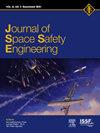表征人类深空飞行任务异常响应能力和功能限制的系统方法
IF 1.7
Q3 ENGINEERING, AEROSPACE
引用次数: 0
摘要
由于距离地球极远,任务持续时间长,人类对火星及其他地方的探索将需要前所未有的自给自足水平。这种模式的转变需要开发新的异常响应架构,以充分保护未来的工作人员免受异常和故障的影响。本文概述并演示了一个识别和评估影响深空操作异常响应过程的关键因素的过程。它建立在已建立的框架之上,说明了这个活动是多么的复杂和相互依赖。通过文献综述,结合已建立的分类过程,建立了当前最先进的异常响应的相关因素。然后通过案例研究评估这些因素对地球依赖的特定属性。在本文中,我们确定了超过120个相关的异常响应因素,并开发了一个过程,该过程允许识别需要集成到未来栖息地设计中的系统功能,以提供最低水平的自给自足,以保护机组人员免受由通信延迟和因素复合相互依赖引起的灾难性后果。虽然这个过程是使用假设的火星任务约束来演示的,并根据当前的国际空间站过程作为基线进行了评估,但通过相应地修改相关的任务约束和操作能力属性,可以将概述的方法适用于需要不同形式的系统自主性的异常响应设计。本文章由计算机程序翻译,如有差异,请以英文原文为准。
A systems approach for characterizing human deep space mission anomaly response capabilities and functional constraints
Human exploration of Mars and beyond will demand unprecedented levels of onboard self-sufficiency due to the exceedingly far distances from Earth and lengthy mission durations. This paradigm shift will require the development of novel anomaly response architectures to protect future crews adequately from anomalies and failures. In this paper we outline and demonstrate a process to identify and evaluate key factors that affect the anomaly response process for deep space operations. It builds on established frameworks, illustrating how incredibly complex and interdependent this activity is. Relevant factors of the current state-of-the-art anomaly response were established through a literature review in combination with an established taxonomy process. These factors were then assessed for their Earth-reliance specific attributes through a case study. In this paper we have identified over 120 relevant anomaly response factors and developed a process that allows for identifying system capabilities that need to be integrated into future habitat designs to provide a minimum level self-sufficiency to protect crews from catastrophic outcomes stemming from communications delays and compounding co-dependency of factors. While this process was demonstrated using notional Mars mission constraints and evaluated against current ISS processes as the baseline, the outlined approach can be adapted for anomaly response designs that require different forms of system autonomy by modifying the relevant mission constraints and operational capability attributes accordingly.
求助全文
通过发布文献求助,成功后即可免费获取论文全文。
去求助
来源期刊

Journal of Space Safety Engineering
Engineering-Safety, Risk, Reliability and Quality
CiteScore
2.50
自引率
0.00%
发文量
80
 求助内容:
求助内容: 应助结果提醒方式:
应助结果提醒方式:


